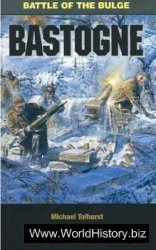The regiment ordered the 3rd Battalion to establish a defensive position along the south edge of Defuy Woods with the left wing resting on the eastern corner of the woods.
Astride the woods, the 2nd Battalion was to prolong the line on the left of the 3rd Battalion. The 1st Battalion established the regimental reserve line north of the Defuy Woods. The regimental command post was on the left of the 1st Battalion.
The sector assigned to the 2nd Battalion—a long, barren ridge devoid of cover—did not please us at all. Positions on this ridge would be especially exposed to French artillery fire. We would have preferred the 3rd Battalion's position in the woods.
Our recent experiences indicated but one way of keeping casualties down— the deep trench. Company sectors were assigned, and the company commanders — three of them young lieutenants — were impressed with the vital necessity of seeing that the men dug without regard to fatigue. The main part of the work had to be finished before midnight. Between then and daybreak a few hours' rest could be taken, but shortly before dawn the work had to be continued. The trenches were to be five and a half feet deep.
Soon the whole battalion was hard at it. The violence of the enemy artillery fire the day before had impressed us all with the value of spade work. Even the battalion staff consisting of battalion commander, adjutant, and four messengers dug itself a twenty-foot trench back of the centre of the 8th Company which was located in front and on the right. The work was tiring, the ground proved to be hard as a rock, and it was almost impossible to accomplish anything with the short spades. Since only a few picks were available our progress was very slow. The men had not eaten since 0500, and at 2230 the battalion commander sent me to Pretz to bring up the kitchens. I got back at midnight with mail as well as food. This was the first mail we had received since the outbreak of the war.
At the end of several hours' digging the trench was some eighteen inches deep, which was certainly insufficient protection from hostile artillery fire. That meant more work before morning; but right now, at midnight, the men were completely exhausted. First they must be fed and get some rest. The kitchens arrived, the men were given food, and mail was distributed. In the narrow trench and by candlelight the men read letters which had been mailed from home weeks before. The letters came from another world, and yet we had not been away for years—just a few eventful weeks. The meal finished, back we went to our picks and shovels. The battalion staff did not rest until early morning, at which time our trench was about forty inches deep. Our blistered hands ached, and we were so tired that we felt no discomfort in dropping off to sleep on the hard ground in the quiet of an early September morning.
And now the companies were back at work! On the eastern edge of the woods we saw a gun section of the 49th Field Artillery going into position on the boundary of the 2nd and 3rd Battalions and some thirty yards behind the front line.
On September 8 there was no activity during the early morning hours. On the other side of the valley, the glasses showed enemy defence positions on Hills 267 and 297 (west and northwest of Rembercourt). We had visual contact with our neighbours on the left, the 120th Infantry Regiment located on Hill 285; and provisions had been made to sweep the six hundred-yard gap with fire. A heavy machine-gun platoon had gone into position in our sector. The 5th and 8th Companies were in the front line; the 6th and 7th Companies were echeloned behind the right and left flanks respectively. The battalion commander took me on his tour of inspection, and we found the men working hard. In some places the trench was now four and a half feet deep.
Then French artillery opened up at 0600 and the heavy fire directed at us put all their previous efforts in the shade. The air was full of sound and fury, and the ground around us shook as if an earthquake had hit us. Most of the fire was with time fuzes which burst over us, but some impact fuzes were also being used. We lay huddled in our miserable trench with little protection against fragments from shells that burst in our vicinity. The bombardment maintained this intensity for several hours. On one occasion a shell struck the slope above us and rolled back into our trench, but luckily it was a dud. All of us were working to deepen the trench, and we used any tool that came to hand—picks, shovels, knives, mess tins, and even bare hands. One could see the men cringe as a shell burst in their vicinity. Along about noon, the enemy fire slackened and gave us our first opportunity to send runners out to the companies. Everything was in order, and there were no signs of French infantry. Fortunately, our casualty rate during the bombardment was only some three percent, much less than we had feared it would be. The enemy soon stepped up the intensity of fire again. He must have had enormous quantities of artillery ammunition on hand. In contrast to this, our artillery was silent during most of the day, a silence imposed by a dearth of ammunition.
The French artillery kept it up all afternoon, but by now our trenches were seventy inches deep. Some men had dug fox-holes for themselves in the front wall of the trench. Not even time fuse fragments could reach them there, and with twenty inches of hard soil above them they had protection even against shells with impact fuzes.
Toward evening the enemy raised his volume of fire to a terrific pitch and threw everything he had at us. A thick pall of black smoke from his medium artillery drifted across our positions. Shells ploughed up the slope and filled the air with dirt and stones. This might have been their preparation for an infantry attack. —Let them come,” we said; we had been waiting for them all day.
The French artillery ceased fire as suddenly as it had begun, and the infantry attack did not come. We crawled out of our holes, and I made a tour of the four companies. The casualties were surprisingly small (sixteen men out of the battalion); and in spite of the severe nervous strain, the men were in the best of spirits. Their digging before and during the bombardment had paid big dividends.
The last rays of the setting sun lighted up the battlefield. Over to the right we saw the two guns of the 49th Field Artillery and about them their crews dead or badly wounded. The platoon's cover was such that shooting was impossible. It looked just as bad for the 3rd Battalion in the woods on our right. There, dense undergrowth made entrenching practically impossible. Concentrated French artillery fire, especially flanking fire, had had its effect heightened by damaged trees which fell on the troops and played havoc with various companies.
I went back to the regimental command post for orders and food. Colonel Haas was badly broken up over the heavy casualties in the 3rd Battalion, which had to withdraw from the woods. The 2nd Battalion was ordered to hold the hill to the east of the woods. The 2nd Battalion was ordered to hold the hill to the east of Defuy Woods without support on either flank. In conclusion, Colonel Haas said, “The 124th Regiment will die in its positions.”
On my return to the battalion the right flank of the 8th Company was redeployed on a front curving to the rear. The 6th Company took up a position with its front along the eastern edge of Defuy Woods and dug in. The other units continued improving their positions and the field kitchens arrived shortly before midnight. Again they brought mail with them. It was a repetition of the preceding night, the men resting for a few hours on the bare ground. The following day, the French artillery began firing at the same hour as on September 8, but from our good deep position we paid small attention to it. Part of the time we had telephone connections with the regiment, but shells kept breaking the line. I spent considerable time with the 5th Company and examined the enemy's positions with Sergeant Bentele, of the 7th Company.
The French artillery was principally in open positions, and even the French infantry was exhibiting a great lack of caution. I prepared a report, complete with sketches, and sent it through the battalion to the regiment along with the request that artillery observers be sent forward to the 2nd Battalion.
The left of the 120th Infantry was on the south slope of Hill 285 and some six hundred yards away, with the French across the way along the railroad tracks. French reserves were massed in a cut half a mile west of Vaux Marie station. From a knoll to our left we could reach them with flanking fire and probably cause considerable damage. I suggested this to the machine-gun platoon commander, but he had his doubts and declined. Taking matters into my own hands, I assumed command of the platoon, being well aware that we would have to work at top speed if we wished to avoid counter-measures from the French artillery. Within a few minutes our machine guns were firing into the massed enemy reserves, causing much confusion and a number of casualties. Our mission accomplished, we pulled out in a hurry and headed for cover; French counter-battery fire that followed hit empty positions. We suffered no losses, but during the operation the machine-gun platoon commander complained to the regimental commander regarding my arbitrary assumption of command. My explanation to the regimental command post was satisfactory and the matter ended.
During the day several artillery observers arrived in our sector. The layout of the French artillery was given them, but their ammunition supply was so small that the enemy artillery was not disturbed by our weak fire. However, one of our heavy batteries forced the enemy batteries located in Rembercourt to displace.
The evening was a repetition of the previous day. The French artillery —kissed us goodnight” by firing enormous quantities of ammunition. Then silence reigned. As far as we could make out, the French artillery was displacing to the rear.
We resumed our work in order to make our shelters bombproof, and several detachments went into the woods to cut trees. Fortunately, our casualties were lower than the day before, some occurring in the 6th Company as a result of flanking fire delivered against it. At about 2200 the field kitchens arrived and 1st Sergeant Rothenhaussler of the 7th Company brought a bottle of red wine and a bundle of straw. Shortly before midnight I lay down on the straw close to the Battalion command post.
Observations: The 3rd Battalion paid dearly for having established itself close to the southern edge of the woods. In this position it suffered extremely heavy casualties and had to be withdrawn during the night of the 8th. The heavy French artillery fire produced devastating results among the troops stationed in and on the edge of the woods. These units were not dug in properly. Many shells, which on a bare ridge would have been harmless “overs " caused damage among the troops by striking and exploding among the tree-tops. The forward edge of the woods was a death trap, and the French adjustment of fire there was very easy. Today artillery fuzes are even more sensitive and the losses in a similar case would be even greater.
In contrast to this, the 2nd Battalion’s pick-and-shovel work on the barren hill paid large dividends. In spite of an artillery bombardment lasting for hours, our casualties were very small. Time fused shells were quite unpleasant, for many of their fragments flew straight into the trenches.
The hard soil in the 2nd Battalion sector made digging difficult. It required all command powers, as well as personal example on the part of unit commanders, to force the tired and hungry men to dig their utmost during the night of September 7-8.
From September 7 to 9, the French artillery expended considerable quantities of ammunition. It had full stores to draw on, for the main sector dumps were close at hand. On the German side, we were running short of artillery ammunition and consequently the long arm could not render adequate support to the infantry.
Modern defence organization differs greatly from 1914. Then we had a front line with the remaining troops disposed in a second line. Today (1937) a battalion position consists of an outpost line and a main battle position through which the forces are organized in great depth. In an area eleven hundred to twenty-two hundred yards wide and deep, we have dozens of mutually supporting strong-points garrisoned by riflemen, machine guns, mortars, and antitank weapons. These dispositions cause the enemy to divert his fire and the defence to concentrate its own fire. Local manoeuvre under covering fire is possible, and aggressive counter-measures can be instituted should the enemy succeed in penetrating the main battle position. The enemy has a long and very difficult road before breaking through.




 World History
World History









